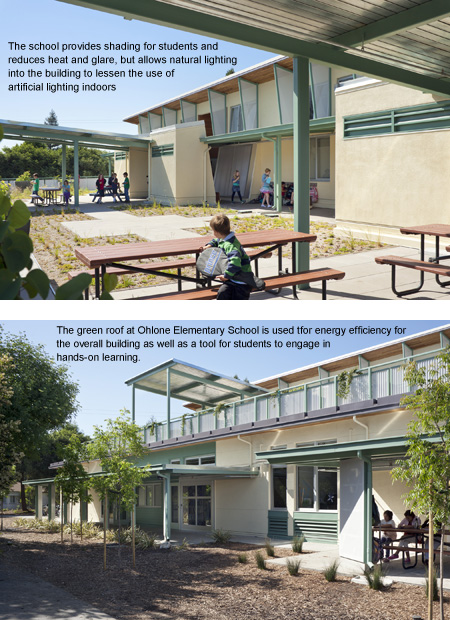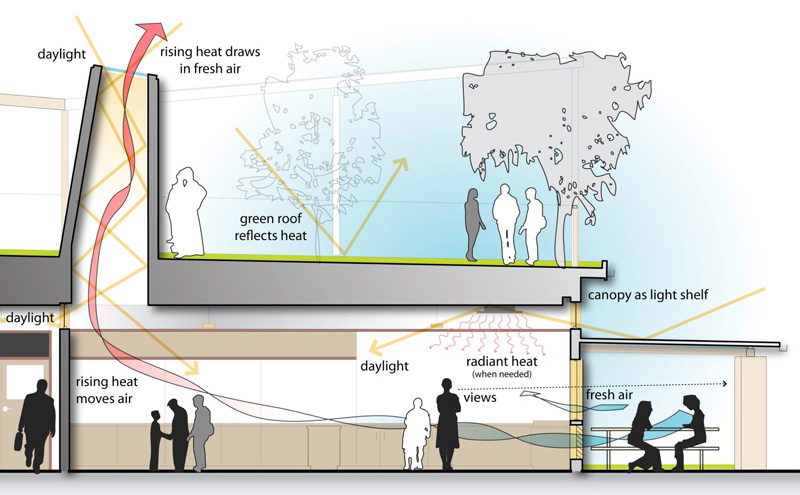 By Lisa Gelfand, founding principal, Gelfand Partners Architects
By Lisa Gelfand, founding principal, Gelfand Partners Architects
The Palo Alto Unified School District (PAUSD) passed a $378 million school facilities bond in 2008, resulting in changes for the district. The school board resolution of placing the bond on the ballot requires that each building project incorporate California Collaborative for High Performance Schools (CHPS) standards and best practices in construction as well as maintenance work.
If that was where the PAUSD commitment stopped, it would not be that different from the dozens of other districts that have passed resolutions committing to CHPS standards in design and construction. However, the district also stands out in the extent of partnerships with external public and private resources as well as involvement of school communities. PAUSD aims to incorporate sustainability in the classroom and change behaviors and operations in everything from school lunch containers to waste and care of the landscape.
The first project our office completed, a new wing for the Ohlone Elementary School, demonstrates how community involvement and sustainability affect design and construction. Ohlone is an alternative elementary school, drawing enrollment fromall over the school district. It has a long tradition of involving children in hands-on learning as exemplified in the Ohlone Farm. The campus is home to chickens, sheep, goats and bees, as well as a small orchard, an indigenous plant and pond area and extensive gardens.
The school describes the farm as “a physical embodiment of Ohlone’s Core Values.” So when we sited the new building next to the farm we were careful to mass the building in such a way that it would not shadow the farm. We were able to locate the new science classroom next to the farm, and to create a green roof on the one-story part of the building. The mass of the building, with its two-story wing on top of a broader one-story base, provides access to the outdoors for second floor classrooms, and makes the roof space valuable learning space. The roof of the higher wing faces south and was planned for addition of photovoltaic panels when that becomes feasible economically.
The building will be a CHPS-certified building and will qualify for the State of California High Performance Incentive grants. Within the building this means optimizing daylighting, natural ventilation, healthy materials, acoustics and energy-efficient mechanical and electrical systems. The envelope includes the green roof and a system of shelves and screens designed to baffle direct light to avoid heat and glare, but to admit pervasive daylight. Light towers on the second floor balance ground floor lighting of both classrooms and hallways, while the top floor classrooms take advantage of clerestory windows on both sides of the classroom.
The Ohlone Farm is closely identified with Ohlone Elementary School; however, community partnerships with PAUSD do not stop there. A community-based Sustainable Schools Committee organized a wide range of activities, from keeping an eye on the success of the various building project teams in meeting sustainable goals, to coordinating “green teams” at the various schools, to working with Canopy, a local environmental nonprofit concerned with urban forestry. The city of Palo Alto helps facilitate the formation of the school’s green teams.
The city of Palo Alto does not restrict local initiatives, but they do bring or share ideas such as bike-to-school events, eliminating plastic bags in kids’ home lunches, or reducing waste at football games. Such activities help to focus on the city of Palo Alto’s goal of zero waste — the virtual elimination of waste being burned or buried by 2021.
Palo Alto progress in diverting waste. PAUSD has 17 campuses including more than 228 acres. The Board of Education has taken another principled stand to protect the trees that are such an important part of the environment in this mature suburban district. Canopy, the Sustainable Schools Committee and district staff collaborated on a policy of tree protection, preservation and selection that was formally adopted by the board in June 2011. While many building programs are ruthless in the removal of existing trees to make room for new buildings, Palo Alto affirms their values. This can add considerable complexity to construction projects, with extensive protection of heritage trees and constraints on sites for new buildings.
Palo Alto has a municipal power company. It has assisted the district with energy audits of the schools and suggestions for energy conservationmeasures that can be undertaken independent of modernization efforts or other bond work. Ironically, its low rates and favorable commercial terms with the district make it difficult to make the economic case for photovoltaic generation at the school sites. Pay back times are longer than in areas served by commercial utilities. This focuses the district’s attention on conservation first, though all new buildings are designed for potential addition of photovoltaic panels.
The city of Palo Alto also runs recreation programs on athletic fields located at the school sites. Efficient irrigation and appropriate turf selection guide the city and the district in creating sustainable fields.
These examples of partnerships — the parent-led Ohlone Farm Council, cityfacilitated green teams, non-profit assistance from Canopy in tree preservation, and municipal utility support of energy conservation — all assist the district to achieve high degrees of sustainability while concentrating district resources on its core mission of education.
At Ohlone, the new wing makes visible the community commitment to sustainable school design, supports the environmental curriculum and maintains meaningful access of children to the outdoors, even on the second floor. Its high performance characteristics will support healthy classrooms that are well-lit, quiet, comfortable and will save money for the life of the building.

School Construction News: A Sustainable Approach, by Lisa Gelfand